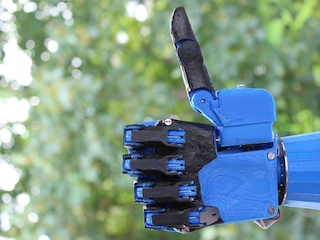Print Me a New Arm, Please - Bionics and 3D Printing add to a Revolution in Medicine
 Kim BellardI just realized that I hadn't ever really written about two hot trends in health care: bionics and 3D printing. I better get to it before they become mainstream, or are superseded by something even newer.
Kim BellardI just realized that I hadn't ever really written about two hot trends in health care: bionics and 3D printing. I better get to it before they become mainstream, or are superseded by something even newer.
Let start with bionics. According to Merriam-Webster, bionic means "having normal biological capability or performance enhanced by or as if by electronic or electromechancial devices." Bionics is the science of this. If you are old enough to remember the 1970's TV series "The Six Million Dollar Man" (or its spin-off, "The Bionic Woman"), bionic implants for their arms and legs gave the title characters greater strength and speed, as well as a bionic eye for Steve Austin and bionic ear for Jamie Summers. Since they were, essentially, prototypes, six million dollars probably was a pretty good deal, even in 1970's dollars.
Flash forward to 2016. Bionics is estimated to be an $8b market (2014), with a projected 13.2% CAGR that would bring it to $20.5b by 2020. The artificial kidney market is said to account for some 60% of the market, with livers expected to be the fastest growing segment over the period.
Here are some other examples:
- We've already got bionic arms, including ones with bionic hands that are controlled by the person's thoughts. Similarly, we've already got brain-controlled bionic legs,
- Bionic eyes are giving sight back to some people who had lost it (even if they can't -- yet -- shoot laser beams like Steve Austin's). We're getting to the point where we can collect visual information and send it in code the brain understands.
- All us aging boomers should be looking forward to bionic joints, either supplementing or replacing the ones we were born with.
- A bionic spine is already being tested in humans, allowing paralyzed patients to walk and move their arms.
- We're getting closer to a bionic pancreas, with companies like Beta Bionics posed to revolutionize treatment of diabetes.
 The Six Million Dollar Man - WikipediaNone of this is cheap, of course, especially since much of it is still considered to be in the experimental stage. A bionic arm might cost $50,000- $60,000, which is a lot more expensive than a conventional prosthesis. Artificial kidneys just need to beat the cost of dialysis or kidney transplants to look economical. I'll bet the medical-industrial complex is practically salivating at the prospect of us all wanting to upgrade and supersize our own equipment.
The Six Million Dollar Man - WikipediaNone of this is cheap, of course, especially since much of it is still considered to be in the experimental stage. A bionic arm might cost $50,000- $60,000, which is a lot more expensive than a conventional prosthesis. Artificial kidneys just need to beat the cost of dialysis or kidney transplants to look economical. I'll bet the medical-industrial complex is practically salivating at the prospect of us all wanting to upgrade and supersize our own equipment.
Which leads us to 3D printing.
3D printing, also known as additive manufacturing, takes a digital file and then, layer-by-layer, prints out a 3D version. It could be a toy, a shoe -- or a body part. 3D is estimated to currently be a $4.1b market, and grow to $16.2b by 2020, with the healthcare portion alone accounting for some $3.89b of that in 2022. Small change, perhaps, relative to the overall manufacturing and/or healthcare markets, but the potential is huge.
Newsweek recently ran an article How 3D Printing Will Make Manufacturing in America Great Again. It may render obsolete the huge manufacturing plants -- increasingly located overseas -- in lieu of smaller plants that can make anything, anywhere. As one 3D printing company CEO told them: "Why would you put a thousand machines in one place when you can put one machine in thousand places?"
3D printers have been somewhat slow, but their speed is getting much, much faster. A company named Carbon is among the fastest, and their CEO thinks even the term "printing" may be outdated. As he told Bloomberg, "We don't print. We grow."
Health care is already benefiting. For example, a 3D printing company named Open Bionics says it can make a custom-fitted forearm and hand within two days, for about $3,000 -- versus traditional prosthetics that could cost thirty times that and take months to build. As their founder told BBC: "We have a device at the lower-end of the pricing scale and upper end of functionality, At the same time it is very lightweight and it can be customized for each person." Open Bionics just won a national award to help develop an affordable robotic, 3D-printed prosthetic arm. (Photo - Open Bionics )
Open Bionics just won a national award to help develop an affordable robotic, 3D-printed prosthetic arm. (Photo - Open Bionics )
Another company, Youbionic, is taking preorders for a 3D bionic hand that run less than $1,500. and is fully functional. As they said: :We have evaluated several choices but we have no doubt that 3D printing is what we believe to [be the] best manufacturing technology projects such as ours."
We've even got 3D pills, which raises the potential not just of reducing the cost of manufacturing drugs but raising the possibility that you could print out your own prescriptions at home. Download the digital file, load it on your home 3D printer, and, bingo, print out your own meds. Aprecia Pharmaceuticals has an exclusive license for an MIT 3D process for printing pills, but they won't be the only ones to go down this route (although not everyone is expecting a rush to it).
Forget transplants, forget implants, forget dental fillings or crowns-- just draw desired structures directly where needed.
Bionics and 3D printing are pretty cool, and will impact health care in ways we do not yet fully appreciate. Bionics are getting so good that people like Hugh Herr are already raising the question of whether some people might amputate their own limbs to get bionic ones.
After all, back in 2012 some athletes complained that Oscar Pistorius had an unfair advantage with his prosthetic legs, so imagine how they'd feel if a runner got bionic legs. By the same token, why do laser eye surgery to correct your vision if you could just get a newer, better bionic eye? It's hard to say where bionic options could lead, especially as they get both better and cheaper.
Of course, once we have nanotechnology and/or gene therapy to fix problems at a cellular level, even bionics and 3D printing may become outdated. But those are topics for another day.
| Print Me a New Arm, Please - Bionics and 3D Printing add to a Revolution in Medicine was authored by Kim Bellard and first published in his blog, From a Different Perspective.... It is reprinted by Open Health News with permission from the author. The original post can be found here. |
- Tags:
- 3D bionic hand
- 3D pills
- 3D printing
- Aprecia Pharmaceuticals
- artificial kidney
- artificial kidneys
- Beta Bionics
- bionic arms
- Bionic eyes
- bionic hands
- bionic joints
- bionic pancreas
- bionic spine
- bionics
- biopen surgeons
- Bioprinting
- brain-controlled bionic legs
- Carbon
- diabetes
- electromechancial devices
- Hugh Herr
- Jamie Summers
- kidney dialysis
- kidney transplants
- Kim Bellard
- medical-industrial complex
- MIT 3D process for printing pills
- nanotechnology
- Open Bionics
- Oscar Pistorius
- prosthetic legs
- repairing cartilage
- Steve Austin
- The Six Million Dollar Man
- traditional prosthetics
- Youbionic
- Login to post comments